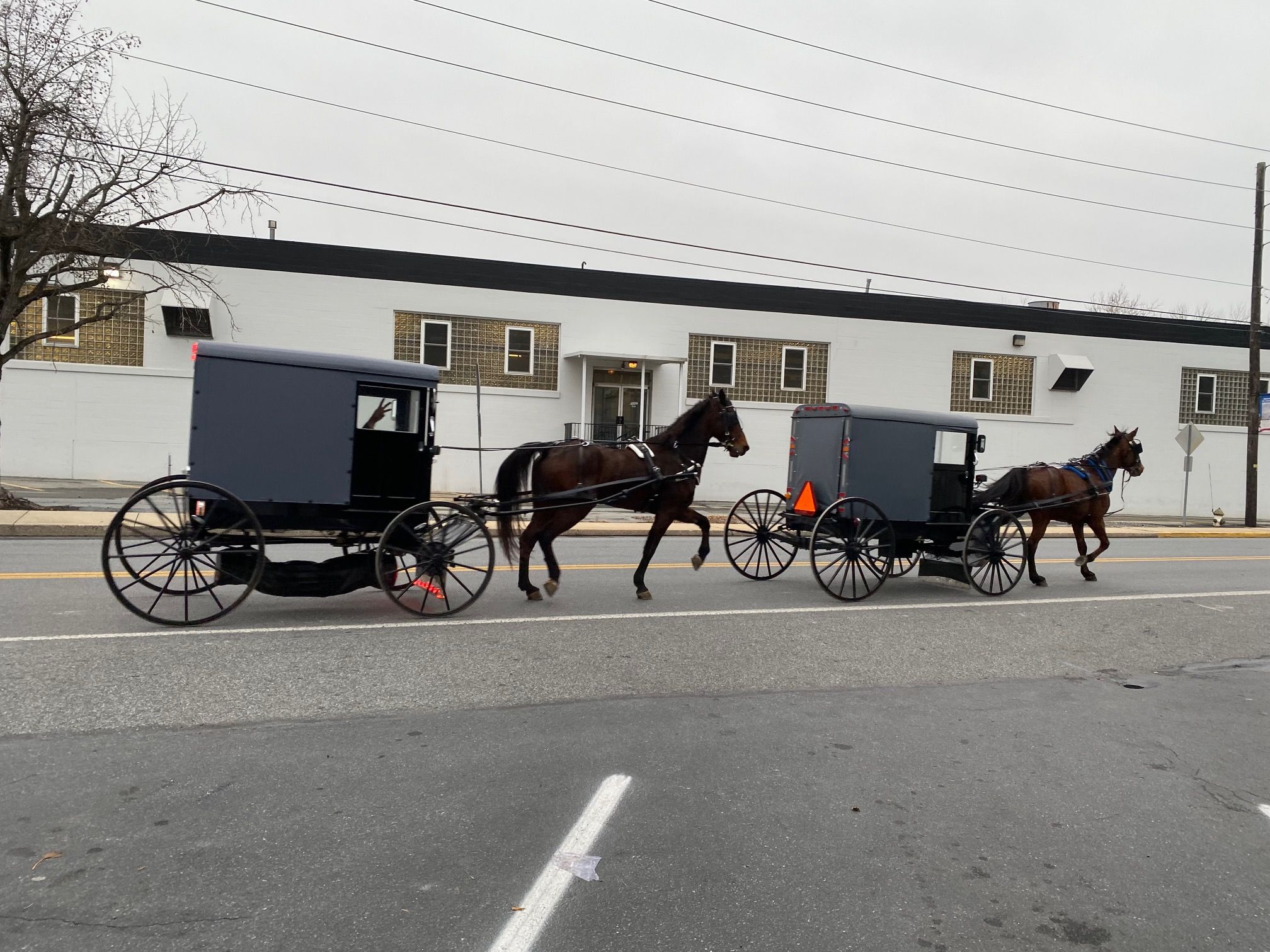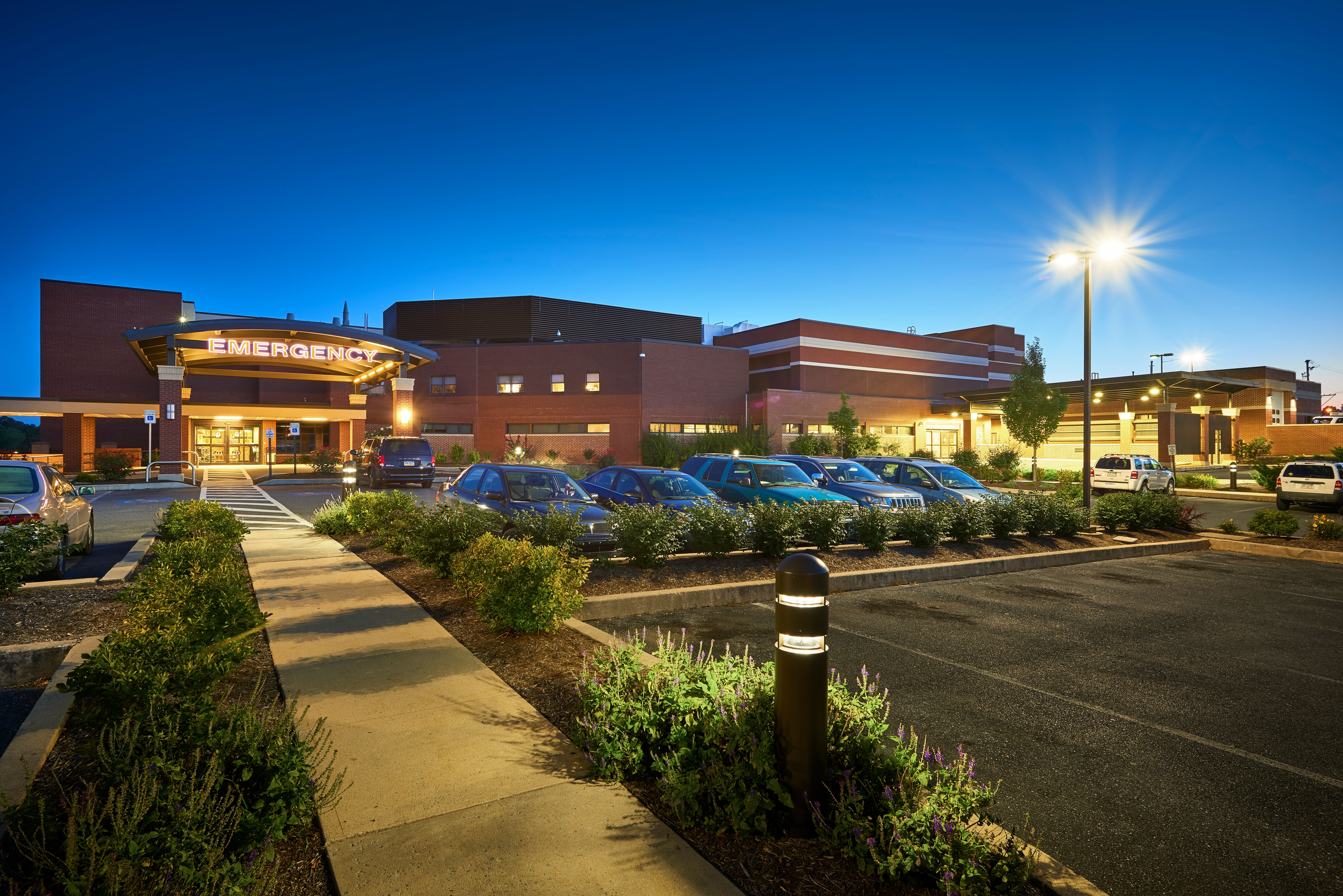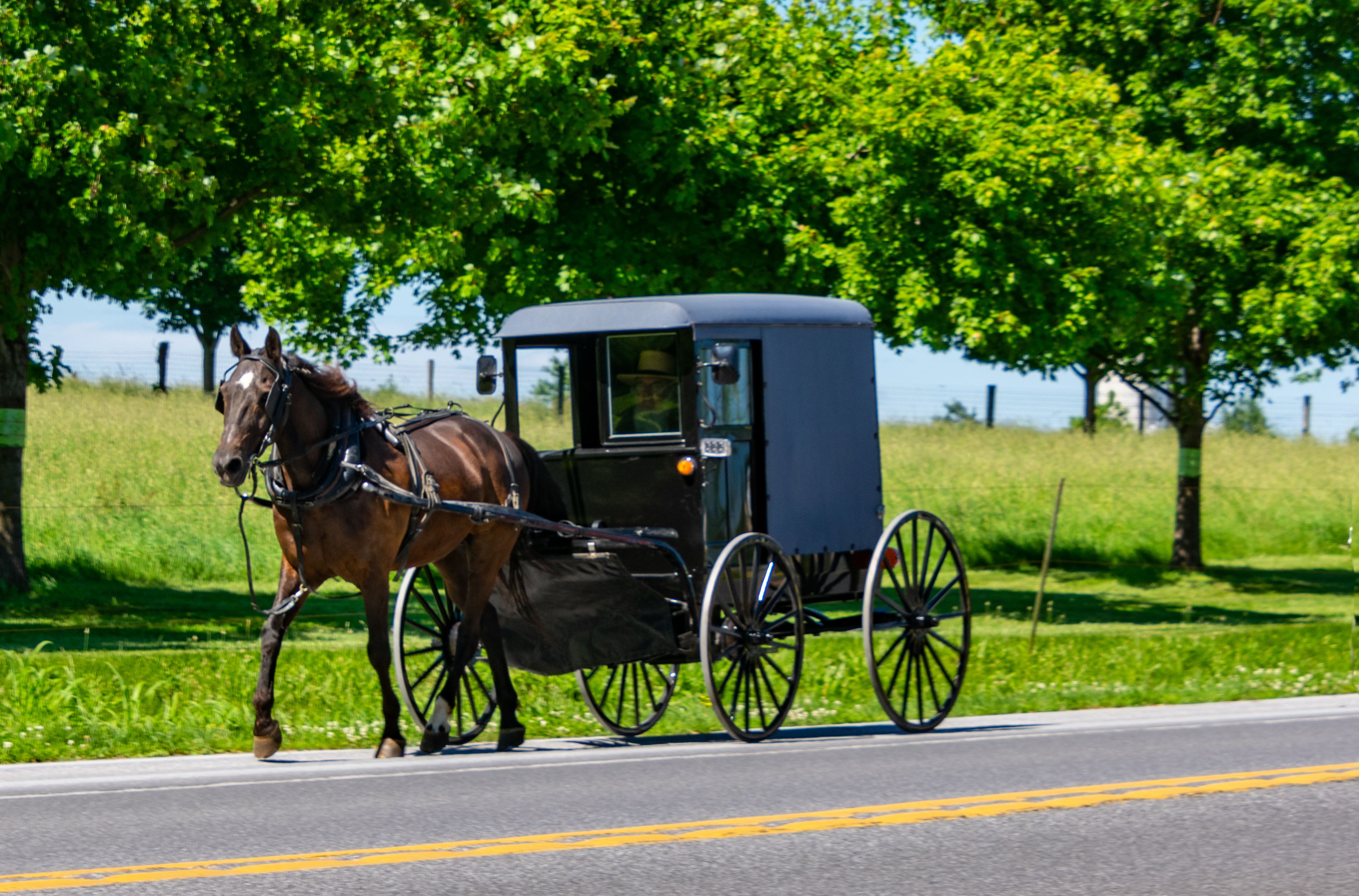The Amish and healthcare: WellSpan Health connects with trust and humility
The Pennsylvania system is aiming to improve health in the Plain communities. WellSpan’s leaders talked with Chief Healthcare Executive about the challenges and lessons of working with the Amish.
Two Amish buggies move down a road in Lancaster County, Pennsylvania. The Keystone State is home to more than 80,000 Amish, and WellSpan Health is aiming to improve health in Plain communities. (Photo: Ron Southwick)

In rural communities across Pennsylvania, horses and buggies remain a common sight, sharing roads with SUVs and sports cars.
More than 86,000 Amish residents live in the Keystone State, maintaining their own way of life largely, but not completely, separate from the “English.” Pennsylvania maintains the largest Amish population in America, although Ohio is close behind.
The Amish typically reject many facets of contemporary life, such as computers and television, and cling to their Christian faith. They have preserved their culture for generations, but they are showing more willingness to engage with modern healthcare.
WellSpan Health has worked extensively with central Pennsylvania’s Plain communities, and the system is trying to improve healthcare among Amish and Mennonite families. Like the Amish, Mennonites maintain a deep Christian faith, but they are more comfortable with modern life, as many drive cars and use technology.
Some Amish leaders approached Ephrata Community Hospital (now part of WellSpan) about 20 years ago. The hospital is in Lancaster County, home to more than 30,000 Amish residents. Initially, Amish leaders asked for help because healthcare has become increasingly expensive and they pay out of pocket, said Joanne Eshelman, WellSpan’s director of plain community relationships.
“It really grew into more than that, because we built a team of liaison support to help folks navigate an increasingly complex healthcare system,” Eshelman said.
WellSpan is offering primary care services, labor and delivery and behavioral care services to the Plain communities. Eshelman and Keith Wright, WellSpan’s medical director, spoke with Chief Healthcare Executive about serving the Amish, building trust, and balancing informed consent with respect for faith and tradition. (WellSpan Health leaders talk about working with the Plain communities in this video. The story continues below the video.)
Building relationships
WellSpan’s liaisons work with Amish and Mennoite communities throughout its service area.
“Our liaisons have a lot of trust in the Plain community population, and the folks that are working for us right now have a long history of serving those individuals,” Eshelman said.
WellSpan’s clinicians hold annual meetings with Amish and Mennoite leaders. The meetings began on financial issues, but have evolved into educational opportunities on healthcare.
In 2019, WellSpan organized a group to improve the health of the Plain population, a coalition that included healthcare providers from across the region and the Pennsylvania Department of Health, Wright said.
The timing proved to be fortuitous, since the COVID-19 pandemic arrived in early 2020.
From the beginning, WellSpan shared with the Amish communities what they knew about the coronavirus.
WellSpan staff presented “accurate information as we understood it at the time, trying to answer people's questions as openly as we could with the information that we had, and realizing that we didn't know everything,” Wright said.
Wright said staffers approached the Plain with humility and candor, explaining, “This is what we know now. It may change. And, you know, maybe we will do things now that we look back and say, well, we could have done that better. But we're doing the best we can with the information we have at the current time.”
“And I think when you combine all of that, trust, transparency, humility, you know, and consistency with relationship building in the long run, then that helps us get through these harder times,” Wright said. “And we’ll come out ahead because people will rely on us even more hopefully, in the future to provide accurate information and give them the health care, access and information that they need.”
Even communicating about COVID-19 requires a different approach.
“We are very attuned to the communication channels that we need to use to reach this group,” Eshelman said. “And that's why we jumped in very early on with some hard copy direct mail communication to folks with factual information knowing that they weren't going to be using the internet. They're not going to be seeing things on television.”
WellSpan advertised in publications read by the Plain communities and held several conference calls, Eshelman said.
“It's understanding that if we want to get the word out on anything, we need to use the right channels to reach that population,” Eshelman said. “And that's true of lots of different specialized populations.”
WellSpan has worked to distribute COVID-19 vaccines to the Amish, with mixed success.
“We have done a lot of work collaborating with others in this region, on education about COVID vaccine, but the receptivity has probably not been as great as any of us would have hoped,” Eshelman said. “But each one to me was really a victory.”
WellSpan Ephrata Community Hospital has been working with Amish residents for years. (Photo provided by WellSpan Health)

How Amish view healthcare
Contrary to what some may think, Amish communities don’t discourage their communities from obtaining healthcare.
“A lot of us would think that the church would prohibit certain things like vaccinations, and that is not generally the case,” Wright said. “The bishops don't generally advocate for or against most healthcare … They leave that up to the individual, family, and patients.”
The Amish aren’t uniform in their practices. Different communities and church districts have different views and practices, Wright said.
Some Amish can be wary of how getting vaccinated is perceived by others in their community. Wright said one Amish bishop got the vaccine, but didn’t want to tell anyone else in his community, not even his wife.
WellSpan has been working to help Amish communities see the value of preventive care, including screenings for breast cancer and colon cancer.
“Conversations about preventive care have always been a challenge with this population,” Eshelman said.
“Building that receptivity to get something checked out that doesn't appear to be broken, is a challenge,” Eshelman said. She added, “That is a challenge for all people, but especially in a population that is paying for care out of their pocket. So we try to make those screenings as affordable as we can, but it's still an uphill climb.”
When Amish are diagnosed with a serious illness such as cancer, Wright said the discussions about treatment options can be complicated.
The Amish place their trust in God. It is their faith that strengthens them through the worst of times, notably seen in their response to the fatal shooting of five children in the West Nickel Mines Amish school in 2006. Five others were wounded.
“The plain community relies a lot on God and each other,” Wright said. “That’s one aspect of their culture that I appreciate. Another is acceptance, which gets through some really hard times like the Nickel Mines shooting. So acceptance and forgiveness.”
However, Wright added, “The negative of that acceptance is, some would view a disease, such as cancer as well, this is God's will. And therefore, you know, they become rather passive in, you know, doing anything to treat that.”
“So we have the conversation that, you know, God does give us wisdom and knowledge about certain things,” he said. “And we have a true informed consent conversation at that point.”
An Amish buggy travels in Lancaster County, Pennsylvania. (Adobe stock)

‘More progressive than the English’
The Amish are turning to WellSpan for behavioral health needs. WellSpan Philhaven hospital provides an outpatient clinic for residents of Plain communities. Some of the staff are members of Amish communities.
“It provides a familiar environment that's culturally appropriate, led by the Plain themselves, with traditional psychiatry and psychology,” Wright said.
“And so it's just an example of how the plain communities come together and provide a resource to bridge the gap culturally between traditional medicine and their culture,” he said.
The Amish approach to behavioral health, and their swift response to help those in need, offer lessons worth emulating, Wright said.
“We think of the Plain community sometimes as not being progressive,” Wright said. “But I think in some ways they are more progressive than the English, in that when they see an opportunity, a gap that is needed, they will sometimes go ahead and act on that a little faster.”
WellSpan has held community forums on behavioral health issues which have been well-attended.
“The educational programs that we have done for the Plain community as outreach, the ones that have had the greatest attendance, have been on behavioral health topics,” Eshelman said. “And that was so striking to me that we would have upwards of 100 people come out for our program on a weeknight to hear about a behavioral health topic, because they want to help each other. And I just find that pretty, pretty special. And remarkable.”
Amish communities are built on a tradition of mutually supporting each other, Eshelman said. If a family has a child with special needs, other members of the community will help with financial resources or transportation.
“If one person is in need, whether it's physical needs, spiritual need, financial need, things that we would refer to as social determinants of health, the community steps in to help to meet that need,” Eshelman said.
“You know, if there is an accident, where there's a loss of life, or loss of ability to earn a living, I have seen the Plain community step in and hold benefit events to raise money to help that family for the long term,” she added. “And it's not just a short-term application of a band-aid to that need. It's a long-term commitment to caring for each other.”
In those instances, WellSpan has the chance to make a difference, she said.
“Sometimes that gives us the opportunity to provide some education on health issues to those who are providing that support,” Eshelman said.
The Amish communities can surprise even those who have worked with them for years. Wright was astonished when one Amish patient was willing to do a visit virtually.
“I had my first video visit with an Old Order Amish patient several months ago, which I didn’t think would happen for a long time,” Wright said. “There are things that surprise us sometimes. I am continually humbled by the differences. They teach me a lot, I would say over time, to get a better understanding of their culture.”
“I think that’s key, with any organization working with a diverse population, is just getting to know, certainly the cultural differences, but realizing under it all, people are people,” Wright said. “They need to be heard and listened to, to provide empathy and give them accurate information. That’s our goal.”
Read more from Chief Healthcare Executive
Penn State Health opens $375M hospital in Lancaster County
Newsletter
Get the latest hospital leadership news and strategies with Chief Healthcare Executive, delivering expert insights on policy, innovation, and executive decision-making.